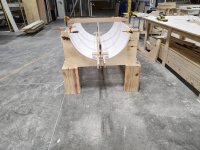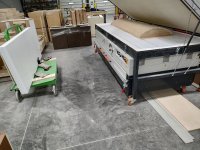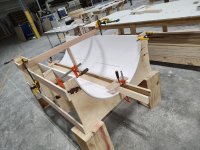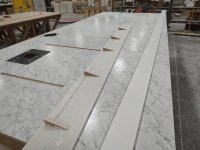[member=41832]WastedP[/member] we do a somewhat hybrid approach. The parts are indeed oversized, because the edges will never be acceptable for gluing. We don't make the parts bigger than the form though, just make the form bigger. I have, in the past, accidentally cut the part too large for the form. At that point, the part was bent around the edge, requiring more trimming than I intended.
[member=44099]Cheese[/member] Yes, the parts are slightly oversize, so they can be cut back to the actual size needed. The halves need to be glued together at a specific diameter, and actually turnout round. In the end, they will get a cap that makes a bit of a ledge. Those parts will definitely be round, so these need to match.
[member=73094]afish[/member] it is a silicone membrane, pretty thick too. When it is cool (room temp) it is tight enough to not droop, but after a few cycles of heat, it sags a bit. It's rather amazing how far it stretches.
[member=75217]squall_line[/member] it has no spring-back at all. Once up to the proper temp, it is soft enough to be called limp. It takes a bit of wrangling to lift it up onto the form because it's so soft. It will lay right down over that form with nothing but its own gravity. It really only needs enough vacuum pressure to keep it from curling up as the exposed side cools faster than the side touching the form. Some care has to be taken with the form construction, because the vacuum can be raised enough to crush a badly built one.
There is another form that we used to rest the pieces in for cutting the straight edge. The first one was done laying in the other form like the one in the pic. I rigged it up to have a flat plane to cut the edge with my MFK700. It was just not stiff enough to give a good edge though, so we abandoned that idea. Then we went to following a straight edge with a router, but it is just too hard to clamp, without the clamps getting in the way. We finally settled on the TS55 and FS3000. It's a little long, but the FS1900 won't reach. I have had a FS2424 on order for weeks, at the local supplier, but it still hasn't showed up. Apparently they are backordered?







